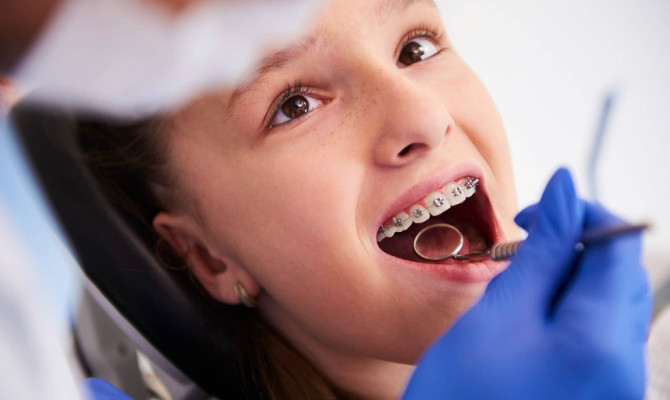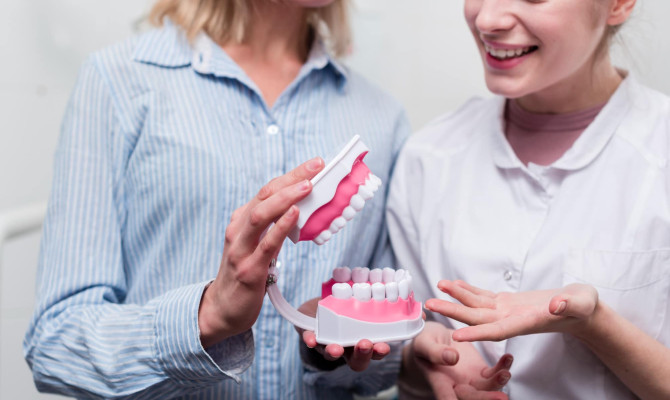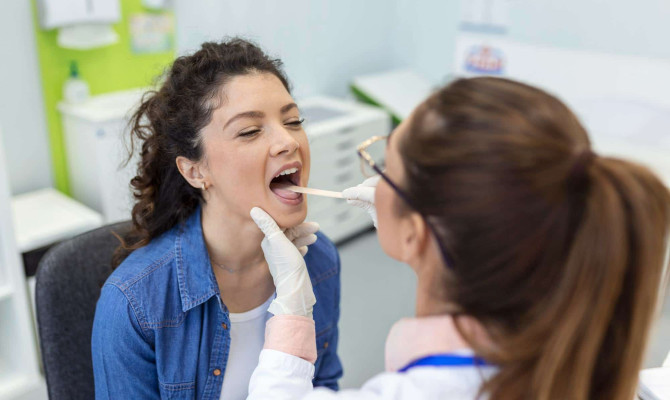Everything You Need To Know About Self-Ligating Braces

- Dental braces
- 02 Oct 2023
Introduction
What are Self-Ligating Braces?
Self-ligating braces are a form of orthodontic therapy used to straighten teeth in a manner similar to traditional metal braces. The brackets used in the therapy include a special door that collects and keeps the arch wire, setting them apart from conventional metal braces. When compared to traditional braces and brackets, this form of brace is reported to cause less mouth friction and discomfort. Self-ligating braces attach directly to the arch wire with the aid of a specific bracket, as opposed to using rubber bands to connect the brackets to the arch wire in regular metal braces.

Although this therapy has been practiced for some time, it has only recently gained popularity due to the advantages it provides to patients. These ceramic or stainless-steel braces are less complicated to adjust than traditional braces, which increases patient comfort and reduces the amount of time orthodontists must spend on modifying the braces. 1 Introduction | Researched based study from Korean Association of Medical Journal Editors , 2 Introduction | Researched based study from Orthodontics Australia
Types
Types of Self-Ligating Braces
Brackets that self-ligate come in two varieties:
- Passive
- Active
Passive brackets:
- With reduced friction and more freedom of movement for the teeth, passive brackets employ a smaller arch wire.
- To aid in the teeth’s initial movement into position during treatment, passive brackets are frequently employed.
Active brackets:
- With active brackets, the arch wire is substantially thicker, applying more pressure to the teeth and pushing them into position more forcefully.
- Additionally, the active brackets provide extra flexibility for reliable, powerful outcomes. 2 Types | Researched based study from Orthodontics Australia
Is it necessary to tighten self-ligating braces?
- Traditional braces need to be adjusted every four to ten weeks to maintain the proper pressure on your teeth.
- During these visits, your orthodontist will also replace the elastic or wire ligatures holding your brackets to your arch wires, and the wires themselves may need to be replaced, altered, or tightened.
- Changing the O-rings or elastic chain also enables patients to select “new colors” for the braces, which many patients appreciate!
- Self-ligating braces still need to be checked frequently to make sure the clip or door is still in place and working properly.
- In order to straighten the teeth of patients with self-ligating brackets, minor arch wire bends must still be placed, and/or elastic ligatures must be used to fill in any remaining voids or prevent spaces from opening during orthodontic therapy.
- Technically, “tightening” the braces still involves all of these processes. 2 Types | Researched based study from Orthodontics Australia
Benefits
Advantages of Self-Ligating Braces
Several stated advantages of self-litigating braces include:
- Hygiene
- Aesthetics
- Convenience
Hygiene
- Self-ligating braces have the advantage of not typically requiring any ligatures to hold the arch wire in place, which is one of their main advantages.
- Ligatures, which are often comprised of elastic, may collect more food particles in and around the orthodontic brackets.
- Ligature-free braces may theoretically capture fewer particles, but to prevent issues, they still need to be cleaned carefully like any other braces.
Aesthetics
- A major selling feature for the self-conscious teenager (not to mention many self-conscious adults) is that self-ligating may be slightly less noticeable depending on their size and design when compared to traditional braces which fail to have an aesthetic appeal.
Convenience
- Self-litigating braces may occasionally require fewer appointments than conventional braces, which may provide the promise of convenience for busy patients by saving time, however, depending on the type of treatment it may differ for each patient. 2 Benefits| Researched based study from Orthodontics Australia
Drawbacks
Disadvantages of Self-Ligating Braces
Self-ligating braces, despite being a novel and promising technology, have the following two major drawbacks which are as follows:
- Complications with the brackets
- Issues with the teeth and gums.
Complications with the brackets
- Throughout a patient’s therapy, the sliding mechanism in self-ligating braces needs to be opened and closed numerous times.
- In contrast to conventional brackets, any moving part is susceptible to malfunction and may require repair. The way you take care of your braces by avoiding foods that are hard and sticky also matters!
Issues with the teeth and gums
- Self-ligating braces, like conventional braces, are more difficult to maintain clean, albeit access to your teeth and gums is a little bit easier because to the absence of elastic bands.
- However, if brushing and flossing aren’t done properly, trapped food particles can accumulate and lead to gum disease and tooth decay if left untreated.
- Therefore, to prevent dental and gum issues, all braces—self-ligating or not—require diligent oral hygiene. 2 Drawbacks | Researched based study from Orthodontics Australia
Self-Ligating vs Metal
Self-Ligating Braces vs Metal Braces
- Self-ligating braces are more comfortable to wear than conventional metal braces since they require fewer frequent adjustments because the clips automatically respond to regular changes in tooth position.
- Self-ligating brackets straighten teeth more rapidly and precisely than conventional braces, requiring fewer orthodontic appointments and a shorter course of treatment.
- In conventional metal braces, rubber bands keep an archwire in place. During routine checks, these rubber bands must be adjusted or replaced as necessary, which can be painful and challenging to maintain. Contrarily, self-ligating brackets do not require rubber bands, making them naturally simpler to clean as there is no risk of trapped food particles causing plaque buildup or cavities.
- Self-ligating brackets help reduce pain from wearing metal braces and eliminate the need for routine wire tightening.
- Compared to self-ligating braces, traditional metal braces might be less expensive, but repeated visits to your orthodontist for adjustments may wind up costing more. 3 Self-Ligating vs Metal | Researched based study from Journal of Dentofacial Anomalies and Orthodontics
FAQs
FAQs about Self-Ligating Braces
Q. Are self-ligating braces better?
- The claim that self-ligating bracket systems are more successful or efficient at treating malocclusions or malalignment of teeth is not supported by any available research.
- Chair time required for self-ligating procedure is 20 seconds lesser for each arch when compared to that of metal brace as per data from few studies.
- According to the available data, there are no differences between self-ligating systems and traditional systems in terms of treatment time, alignment and space closure rates, final arch dimensions, and/or malalignment outcomes which makes self-ligating brace debatable in use when compared to that of conventional metal brace. 4 FAQs | Researched based study from American Journal of Orthodontics and Dentofacial Orthopedics
Q. Which braces move teeth faster?
- Self-ligating braces move teeth faster than conventional braces which achieves the faster movement of teeth by using a cutting-edge technology of spring-loaded clips that fasten the arch wire to the brackets causing the teeth to move more quickly with greater comfort than the conventional brace systems.
- Additionally, since clip mechanism on the brackets does not deteriorate and become loose over time like rubber bands seen in traditional braces, treatment times are shortened with movement of teeth achieved at a faster rate when compared to conventional systems enabling the dentist to avoid use of rubber bands to achieve the movement in teeth. 5 FAQs | Researched based study from Dentaly
Q. How long do self-ligating braces last?
- Self-ligating braces often require the same length of time to work as conventional braces to produce the same results.
- You should expect to wear braces for anywhere from 12 to 30 months on average.6 FAQs | Researched based study from OATUU
Q. Why choose self-ligating braces?
- When compared to other orthodontic treatments, self-ligating braces are a good alternative because they offer advantages such as faster results, fewer adjustments, less friction, and improved hygiene when compared to that of conventional brace systems. 3 FAQs| Researched based study from Journal of Dentofacial Anomalies and Orthodontics
Q. Do self-ligating braces get tightened?
- Self-ligating braces need to be adjusted from time to time, just like conventional braces to achieve progression of movement in teeth.
- Your orthodontist will assess your progress throughout these adjustments, and he or she might also change your arch wire.
- Your teeth may be subjected to less force after adjustments/tightening, allowing them to move into their new locations more gradually. 6 FAQs | Researched based study from OATUU
Q. What is the difference between self-ligating and ceramic braces?
- When compared to ceramic braces, the main difference between the two styles is that self-litigating braces use a special type of clip to hold the wire onto the bracket, which causes less friction on the teeth and requires fewer visits to your orthodontist making it a better choice when compared to ceramic brace. 2 FAQs | Researched based study from Orthodontics Australia
Takeaway
Self-Ligating Braces for Reduced Discomfort & Shorter Dental Appointments
- Adults who do not want to wear metal brackets and wires frequently prefer self-ligating braces because they are more discrete than metal braces.
- Self-ligating braces require less adjustments throughout the course of therapy, which minimizes patient discomfort and the quantity of required office visits.
- Self-ligating braces are significantly easier to clean because there are no rubber bands to trap food particles, which lowers the risk of tooth decay and gum disease.
- Self-ligating braces have a similar appearance to traditional braces, but they are more comfortable and need less time to treat.
- The brackets’ clip mechanism ensures quicker treatment because it does not deteriorate and become loose over time like rubber bands. Additionally, appointments are substantially shorter because the dentist doesn’t have to take the rubber bands off the brackets like conventional brace systems
- Current research suggests that there is no appreciable difference in the efficacy of conventional and self-ligating braces. Consult your orthodontist if you’re interested in self-ligating braces. They can assist in determining if you indeed need a self-ligating brace. 3 Takeaway | Researched based study from Journal of Dentofacial Anomalies and Orthodontics , 5 Takeaway | Researched based study from Dentaly , 6 Takeaway| Researched based study from OATUU , 7 Takeaway| Researched based study from National Institutes of Health
Any feedback on this article?
 This Articles content was accurate
This Articles content was accurate Very Informative Article
Very Informative Article I have a question or a comment
I have a question or a comment
 This article contains inaccurate content
This article contains inaccurate content This article was not helpful
This article was not helpful I have a question or a comment
I have a question or a comment
We appreciate your helpful feedback!
Checkout our social pages
References
-
Korean Association of Medical Journal Editors
Introduction
-
Orthodontics Australia
Introduction | Types | Benefits | Drawbacks | FAQs
-
Journal of Dentofacial Anomalies and Orthodontics
Self-ligating vs Metal | FAQs | Takeaway
-
American Journal of Orthodontics and Dentofacial Orthopedics
FAQs
-
Dentaly
FAQs | Takeaway
-
OATUU
FAQs | Takeaway
-
National Institutes of Health
Takeaway




































